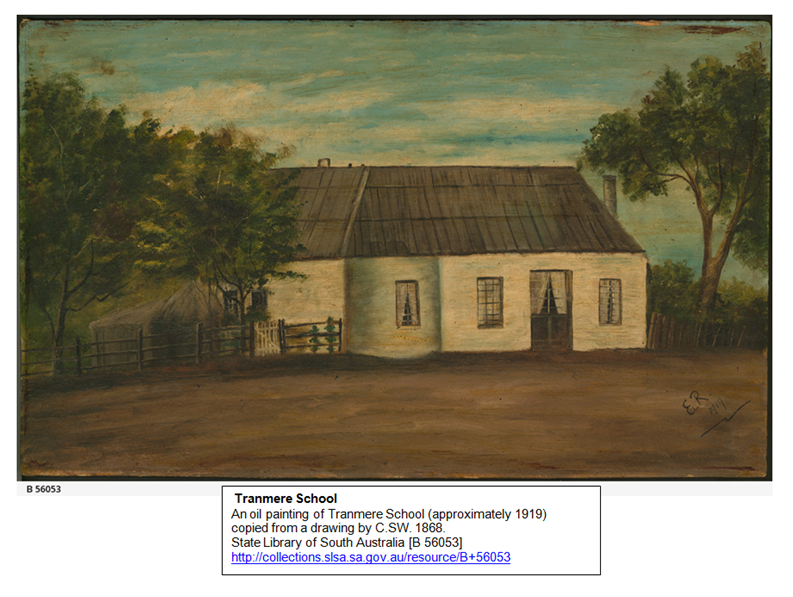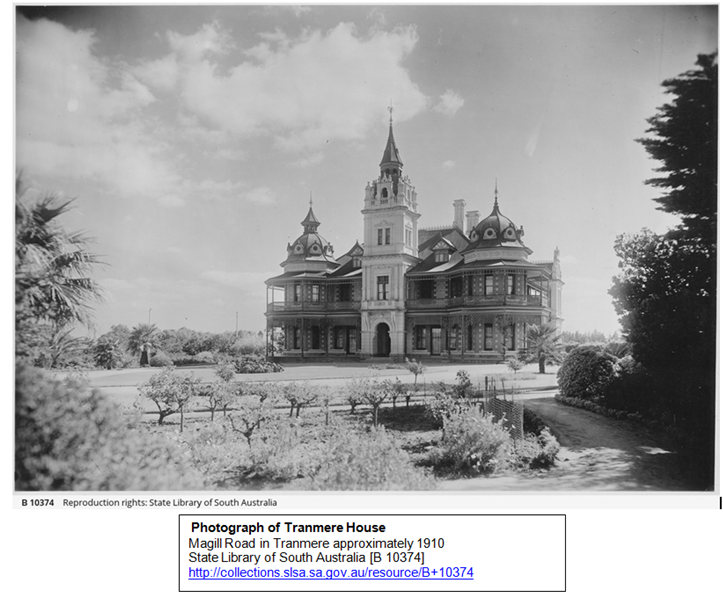Tranmere House
When the Canton arrived in South Australia in 1838 it brought the Wylie and the Scott families to the colony. Mrs. Wylie was the sister of William Scott. They applied for and were granted adjoining 80 acre sections in the new colony. David Wylie was granted section 273, and William Scott was granted section 274. David Wylie was a scholar, with a Bachelor of Arts from Glasgow University. And it was his intention to open a school in South Australia on his 80 acre property, which he named “Tranmere”. The name was also the name of his former domicile in Liverpool, England.1 The name was ideal not only for its relevance to the Mr. Wylie but also to its relevance to their new life. Translated it meant Trans, over or across and Mere, sea. By 1840 the school was operating in the new colony. It was to play an important role in South Australia. Many of the future leaders of the colony attended this school. Mr. Boyle Travers Finniss had two sons who were educated there. As were two sons of William Littlejohn O’Halloran and the two sons of Thomas Quinton Stow. His two nephews, the Scott’s, were attendees as was (Richard) later Sir Richard Chaffy Baker, and Charles J. Dashwood K.C.2 David Wylie and his wife also had ten children of their own. It was in later years when students who had obtained their primary education at Tranmere, and went on to excel at St. Peters College, that this institution became widely known in South Australia. The scholastic achievements of David Wylie had been well known, but it was his ability to impart this knowledge to his pupils that was a respected most.
David Wylie died at the home of his brother in law, Captain Scott M.L.C, on the 8th of August 1853 aged 55 years, after a prolonged period of illness. He is buried in the West Terrace Cemetery in Adelaide.3
In the 1840’s there was money to be made in buying and selling land. The original cost per acre was set by the South Australian Company. After settlement it was sold for whatever the purchaser was prepared to pay. One such speculator was George Morphett, the younger brother of John later, Sir John Morphett. George Morphett was born in London to Solicitor Nathaniel Morphett and his wife Mary, (Nee Gliddon) of “Cummins”, Ide, in Devon. In 1833 he travelled to Egypt to meet up with his brother John. Together they travelled through Egypt, then on to Italy. George then returned to England and in 1835 he married Anne Hitchcock. In 1840 he and his wife immigrated to South Australia. He arrived on board the Brightman in December of that year, along with Mr Robert Torrens.4 The Morphett family set up house in North Adelaide, and George set up in the city in legal practice. Unable to settle they returned to England, but as with many more recent migrants, when they were back in England they missed South Australia. In 1846 with three children, he and his wife returned to Adelaide aboard the Enmore. One of the children,
Whilst in England George was able to lobby the board of the South Australia Company on behalf of brother John, who was anxious to build a railway line from the city to Port Adelaide. George was appointed to the colonial board of the Adelaide Railway Line to the Port.6 John had already been appointed a director of the South Australian Railway Company in Adelaide. When the people of Mount Barker were looking to build a church, George Morphett donated the land, and St. James Church was built in that town.7 He was appointed a director of The South Australian Marine & Fire & Life Assurance Company, as well as The Bank of South Australia, and a director of several mining Companies in the colony. In March 1860 he was elected to The South Australian House of Assembly, in the seat of West Torrens. He was a supporter of Robert Torrens’s Real Property Act. This was the act that simplified the process of changing ownership of Land Titles, and came to be known as Torrens Titles. George Morphett was involved in a number of property transactions in Adelaide. A consortium of Jewish businessmen were looking for a place to build a Synagogue, George Morphett sold them a block of land on Rundle Street. Another businessman in Rundle Street George Hunt a wealthy draper was looking to buy a block of land to build a home to retire to. George Morphett sold him the Tranmere Estate. Soon after this sale he again left South Australia. He left on the Orient on the 31st of October 1860. He was never to return to the colony. His resignation was received by Parliament in April 1861. He died in England in 1893.
In 1897 George Hunt retired and sold his group of draperies (Hunt & Corry & Co) to Wilson Brice & Co.8 during 1898 he built his new home in Tranmere and set about laying out the gardens in his retirement. The house he built was a 17 room mansion. It is heritage listed and is still in private ownership today at 3 Kings Grove Tranmere. It is visible from Magill Road.9

George Hunt came to South Australia as a two-year-old when his family left their home in Ashton in Northamptonshire to start a new life in the new colony. George Hunt Senior. Left England aboard the barque Ascendant in 1849. He selected section 1197, Hundred of Onkaparinga, about 3 km south East of Norton Summit. The property he called Ashton after the village he had left in Northamptonshire. When he subdivided this property, the town took the name of Ashton. In 1866 young George began working in a drapery business in Adelaide. By 1870 he was ready to start out in his own drapery business. Later he formed a partnership with Samuel Corry. The business was a success and they opened four large shops in Rundle Street, opposite the Adelaide Arcade. Because of their success in Adelaide they decided to expand into Western Australia. A further four stores were opened in Northam, Albany, Esperance Bay, and Perth. George was a prominent member of the Pirie Street Methodist Church. He was married twice. His first wife was Elizabeth Guthrie who died in 1875.10 His second wife was Eliza Ann Brusey. He had eleven children by his two marriages. His first wife Elizabeth appears to have died during the birth of a son.11
George Hunt’s partner Samuel Corry died in October 1896. George carried on the business for the next two years then decided to retire, which he did in 1897. In 1860 when the Tranmere property and its 67 acres came up for sale , due to George Morphett wishing to return to England. George Hunt purchased it, always intending to build a house and retire on this property.

In 1912 the house was purchased by Jackman & Treloar. They purchased it for £10,000. Charles Hextall Treloar lived in it for a short period.12 A mystery gentleman wished to rent the house for two years, and use it as an army hospital for returned servicemen, at the end of the First World War.13 After the war money was tight and the mansion proved difficult to sell. So in 1917 Jackman & Treloar decided to convert the mansion into four luxury units.14 These units were the latest thing in luxurious living, but even as rental units they demanded a King’s ransom to lease. Only the rich could afford one of these units. One of the ground floor units was leased to Mr Alf Gard. His great-nephew and namesake was Alf Gard the well known race caller and sports commentator in South Australia. The tenant Alf Gard was one of the Gard Brothers who, together with his brother John Gard, were retailers of bicycles and motor bikes in North Adelaide. They had the agency for the Douglas motorcycle which was a tremendous seller worldwide and made them a fortune.15 In 1923 Mr Treloar granted part of the grounds, on a 15 year lease, with an option to purchase after 3 years, to the Tranmere District Bowling Tennis and Croquet Club.16 They purchased the land and built new clubrooms, along with the ten bowling rinks, four grass tennis courts and two full sized croquet courts. The house was owned by Monica Collins in the early 1940’s and in 1949 it was offered for sale by Mrs. J.A. Clarke. The house was converted back to single occupancy in 1981, and was placed on the State Heritage Register in 1982.
Researched and written by Jim Nelson, volunteer with the Campbelltown Library “Digital Diggers” group.
If you have any comments or questions regarding the information in this local history article, please contact the Local History officer on 8366 9357 or hthiselton@campbelltown.sa.gov.au
References
- The Manning Index http://www.slsa.sa.gov.au/manning/pn/t/t5.htm#tranmere
- News (Adelaide, SA : 1923 - 1954) Wednesday 14 July 1926 p 8
- South Australian Register (Adelaide, SA : 1839 - 1900) Friday 12 August 1853 p 3
- Adelaide South Australian Register (Adelaide, SA : 1839 - 1900) Saturday 19 December 1840 p 2
- removed
- Adelaide Observer (SA : 1843 - 1904) Saturday 2 May 1846 p 4
- Adelaide Observer (SA : 1843 - 1904) Saturday 27 June 1846 p 6
- The Mount Barker Courier and Onkaparinga and Gumeracha Advertiser (SA : 1880 - 1954) Friday 30 July 1897p
- En.wikipedia.org. 2022. Tranmere, South Australia - Wikipedia. [online] Available at: <https://en.wikipedia.org/wiki/Tranmere,_South_Australia> [Accessed 12 September 2022].
- En.wikipedia.org. 2022. George Hunt (merchant) - Wikipedia. [online] Available at: <https://en.wikipedia.org/wiki/George_Hunt_(merchant)> [Accessed 12 September 2022].
- Familytreecircles.com. 2022. HUNT Family of South Australia - 1 :: FamilyTreeCircles.com Genealogy. [online] Available at: <http://www.familytreecircles.com/1-55399.html> [Accessed 12 September 2022].
- SA, B., 2013. SA Bowler December 2013. [online] Issuu. Available at: <http://issuu.com/bowlssa/docs/sa_bowler_december_web_version/12> [Accessed 12 September 2022].
- The Mail (Adelaide, SA : 1912 - 1954) Saturday 29 May 1915 p 24
- The Mail (Adelaide, SA : 1912 - 1954) Saturday 26 May 1917 p 13
- State Library of South Australia. Transcript of Interview with Alf Gard 2012. Full transcript of an interview with Alf Gard. [online] Available at: <http://www.slsa.sa.gov.au/archivaldocs/oh/OH997.pdf> [Accessed 12 September 2022].
- Daily Herald (Adelaide, SA : 1910 - 1924) Monday 26 November 1923 p 3
